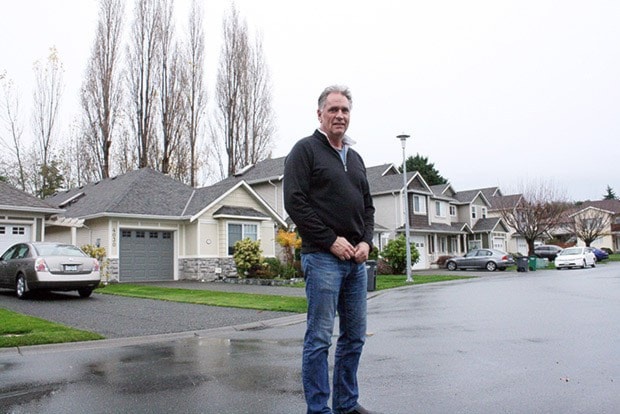A Saanich councillor is claiming victory, even after council rejected his motion to investigate a measure that promises to improve the supply of affordable housing.
Council Monday voted 8-1 against a motion by Coun. Fred Haynes that asked staff to investigate whether a zone permitting smaller homes on smaller lots could be used in other parts of the municipality.
The zone in question – RS-1 – is a site specific zone in the McKenzie Avenue area that permits single-family dwellings on lots with a minimum size of 3,229 square feet with the gross floor areas of homes not exceeding 1,776 square feet. By comparison, the general, non-site-specific RS-2 zone has a minimum lot size of about 4,300 sq. ft with the gross floor areas of homes not exceeding 2,314 sq. ft.
Haynes and others, including members of the development community, argued Monday that increased use of RS-1 zone could help lower housing costs by allowing smaller houses on smaller and thereby cheaper lots, especially in areas ripe for in-filling.
Council, however, rejected Haynes’ request to investigate the mechanics of spreading the zone after receiving input from staff, including chief administrative officer Paul Thorkelsson, who told council that such a move would not be a wise use of resources, because it would trigger an extensive but unnecessary public consultation process.
“That seems, from my perspective, to be an unfortunate approach in terms of dedicating resources and time to that process, when the tool [RS-1] exists, when it can be done,” he said.
“The market will decide whether it is appropriate or not. The developers can tell us whether they can make money off that kind of thing or whether they want some more density.”
Haynes, however, said in an interview that Monday’s vote moves the issue ahead.
“I’m very pleased by the outcome of [Monday’s vote], as it confirms that the dream of home ownership remains alive in Saanich,” he said. “Small lots, small homes are the way to have more affordable opportunities for families seeking single-family homes.”
The vote and the preceding debate confirmed that the RS-1 zone is portable, Haynes said.
“The onus is now on the neighbourhood and the developer to establish appropriate social licence for these types of development, which would need to be within our core areas, which are supported by the [Official Community Plan] and [Local Area Plans] supported for higher density.”
Cam Pringle of Cadillac Homes, who built Saanich’s only RS-1 zoned housing development near the intersection of McKenzie Avenue and Willowbrook Place and supported Haynes’ motion, praised Monday’s vote.
While acknowledging the defeat of Haynes’ motion, he said the vote paves the way for more affordable housing developments in Saanich similar to other communities with comparable zoning. “I think it is great for us and it’s great for the community,” said Pringle.
Travis Lee, president of Tri-Eagle Development, who had also spoken in favour of the motion, echoed those points.
Developers could apply for an RS-1 zoning to round off a subdivision consisting of larger lots, he said.
Lee, however, also lowered expectations. “I don’t necessarily see it as the main part of a development,” he said.
Ultimately, local conditions would decide whether developers would apply for an RS-1 zone, he said.
Thorkelsson struck a similar tone in his remarks. “It may be that there are neighbourhoods and properties where a small lot zone isn’t going to be applied,” he said. “There are local area plans and zones that establish minimum lot sizes and that is not going to change easily.”
Coun. Leif Wergeland picked up on this point when he said that support for in-filling on smaller lots might be less than anticipated.
“I’m not sure the community will really buy into smaller lots on any scale,” he said.
In-filling smaller lots will impact individuals, he said. “We will hear more about traffic, we will hear more about lowering the costs of their homes and will hear about some things that they might just imagine will happen, but we will hear a lot. And I don’t believe this council is prepared to go there.”
While opposition to Haynes’ motion among his council colleagues was unanimous, their respective reception of his proposal varied.
Coun. Dean Murdock said RS-1 has “merit” and should be made available for potential rezoning leading to smaller, more affordable homes.
“What I am hearing is that there is nothing that prevents that from happening now,” he said.
Coun. Vic Derman, however, cautioned against too much density in light of the region’s straining transportation system.
This commentary, however, drew a sharp rebuke from Casey Edge, executive director of the Victoria Residential Builders Association, who expressed disappointment with council’s refusal to further explore the issue. Edge says council’s attitude towards affordable housing contradicts its concerns about the effects of climate change.
“If you want to discourage carbon emissions from traffic from Langford, communities from the core municipalities have to start to embrace small-lot affordable housing, especially Saanich,” he said.
